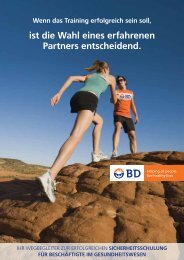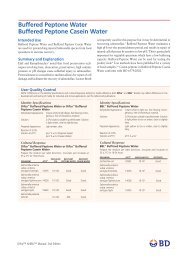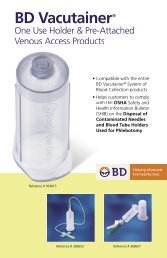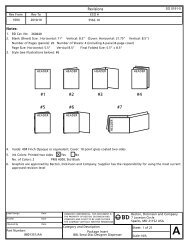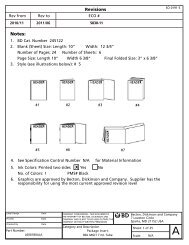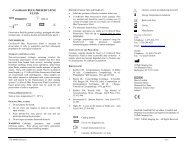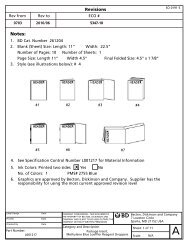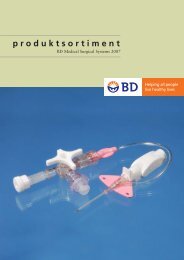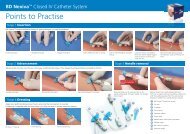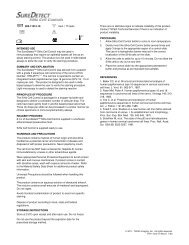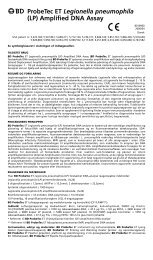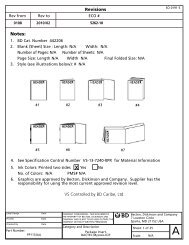BBL™ Brucella Laked Blood Agar with Kanamycin and ... - BD
BBL™ Brucella Laked Blood Agar with Kanamycin and ... - BD
BBL™ Brucella Laked Blood Agar with Kanamycin and ... - BD
You also want an ePaper? Increase the reach of your titles
YUMPU automatically turns print PDFs into web optimized ePapers that Google loves.
BBL <strong>Brucella</strong> <strong>Laked</strong> <strong>Blood</strong> <strong>Agar</strong> <strong>with</strong><br />
<strong>Kanamycin</strong> <strong>and</strong> Vancomycin (KV)<br />
8807321 • Rev. 02 • May 2012<br />
QUALITY CONTROL PROCEDURES<br />
I INTRODUCTION<br />
<strong>Brucella</strong> <strong>Laked</strong> <strong>Blood</strong> <strong>Agar</strong> <strong>with</strong> <strong>Kanamycin</strong> <strong>and</strong> Vancomycin (KV) is used for the selective isolation of fastidious <strong>and</strong> slow<br />
growing gram-negative obligately anaerobic bacteria.<br />
II PERFORMANCE TEST PROCEDURE<br />
1. Reduce plates at room temperature for 18 – 24 h prior to use in a <strong>BD</strong> GasPak EZ anaerobic system.<br />
2. Inoculate representative samples <strong>with</strong> the cultures listed below.<br />
a. For E. coli, streak inoculate 1 µL (0.001 mL) from a 4 – 5 h culture of Trypticase Soy Broth diluted to yield 10 6 – 10 7 CFU/mL.<br />
b. For obligate anaerobes, streak inoculate <strong>with</strong> 10 3 – 10 4 CFU from a 48 – 72 h culture of Chopped Meat Broth that has<br />
incubated for 2 days at 35 – 37°C.<br />
c. Incubate plates at 36 ± 1°C in an anaerobic atmosphere.<br />
d. Include plates of a previously tested lot of TSA <strong>with</strong> 5% Sheep <strong>Blood</strong> as controls for inhibited strains.<br />
3. Examine plates after 48 h for growth, colony color <strong>and</strong> selectivity.<br />
4. Expected Results<br />
Organisms ATCC Recovery Colony Color<br />
*Bacteroides fragilis<br />
*Clostridium perfringens<br />
Escherichia coli<br />
Porphyromonas levii<br />
25285<br />
13124<br />
25922<br />
29147<br />
Fair to heavy growth<br />
Inhibition (partial to complete)<br />
Inhibition (partial to complete)<br />
Fair to heavy growth<br />
Gray<br />
N/A<br />
N/A<br />
Brown-black<br />
*Recommended organism strain for User Quality Control.<br />
NOTE: This medium is exempt from User Quality Control testing according to CLSI M22-A3 Table 1B.<br />
III ADDITIONAL QUALITY CONTROL<br />
1. Examine plates as described under "Product Deterioration."<br />
2. Visually examine representative plates to assure that any existing physical defects will not interfere <strong>with</strong> use.<br />
3. Note the firmness of plates during the inoculation procedure.<br />
4. Incubate uninoculated representative plates at 33 – 37°C for 72 h <strong>and</strong> examine for microbial contamination.<br />
PRODUCT INFORMATION<br />
IV INTENDED USE<br />
<strong>Brucella</strong> <strong>Laked</strong> <strong>Blood</strong> <strong>Agar</strong> <strong>with</strong> <strong>Kanamycin</strong> <strong>and</strong> Vancomycin (KV) is used for the selective isolation <strong>and</strong> cultivation of anaerobic<br />
microorganisms.<br />
V SUMMARY AND EXPLANATION<br />
<strong>Brucella</strong> <strong>Agar</strong> was developed for the cultivation of <strong>Brucella</strong> species from diagnostic specimens, such as blood, <strong>and</strong> from foods<br />
<strong>and</strong> other potentially contaminated material. <strong>Brucella</strong> <strong>Laked</strong> <strong>Blood</strong> <strong>Agar</strong> <strong>with</strong> <strong>Kanamycin</strong> <strong>and</strong> Vancomycin (KV) plates are<br />
particularly useful for the cultivation of fastidious, obligately anaerobic, gram-negative bacilli from clinical materials containing<br />
mixed populations. The combination of kanamycin <strong>and</strong> vancomycin for use in selective isolation of gram-negative anaerobes,<br />
especially Bacteroides, was first described by Finegold et al. 1 Vancomycin, however, may inhibit Porphyromonas asaccharolytica<br />
(Bacteroides asaccharolyticus). 2 The blood has been laked for improved pigmentation of the Prevotella melaninogenica-P.<br />
asaccharolytica (B. melaninogenicus-B. asaccharoylticus) group. 3<br />
VI PRINCIPLES OF THE PROCEDURE<br />
The digests of casein <strong>and</strong> animal tissue supply organic nitrogen. The yeast extract is a source of the B vitamins.<br />
Dextrose is utilized as an energy source. Sodium chloride maintains osmotic equilibrium. The sheep blood, hemin <strong>and</strong><br />
vitamin K 1 provide essential nutrients for certain obligate anaerobes. The laked blood improves pigmentation of the<br />
P. melaninogenica-P. asaccharolytica group.<br />
<strong>Kanamycin</strong> inhibits protein synthesis in susceptible organisms, whereas the vancomycin inhibits gram-positive bacteria by<br />
interfering <strong>with</strong> cell wall synthesis. 4<br />
VII REAGENTS<br />
<strong>Brucella</strong> <strong>Laked</strong> <strong>Blood</strong> <strong>Agar</strong> <strong>with</strong> <strong>Kanamycin</strong> <strong>and</strong> Vancomycin (KV)<br />
Approximate Formula* Per Liter Purified Water<br />
Pancreatic Digest of Casein .............................................. 10.0 g <strong>Agar</strong> ........................................................................15.0 g<br />
Peptic Digest of Animal Tissue ......................................... 10.0 g Hemin .......................................................................0.005 g<br />
Dextrose .............................................................................. 1.0 g Vitamin K 1 ................................................................0.01 g<br />
Yeast Extract ........................................................................ 2.0 g <strong>Kanamycin</strong> ................................................................0.1 g<br />
Sodium Chloride ................................................................. 5.0 g Vancomycin ..............................................................0.0075 g<br />
Sodium Bisulfite .................................................................. 0.1 g Sheep <strong>Blood</strong>, defibrinated, laked ...........................5%<br />
*Adjusted <strong>and</strong>/or supplemented as required to meet performance criteria.<br />
Warnings <strong>and</strong> Precautions: For in vitro Diagnostic Use.<br />
If excessive moisture is observed, invert the bottom over an off-set lid <strong>and</strong> allow to air dry in order to prevent formation of a<br />
seal between the top <strong>and</strong> bottom of the plate during incubation.<br />
8807321 1 of 3
Pathogenic microorganisms, including hepatitis viruses <strong>and</strong> Human Immunodeficiency Virus, may be present in clinical<br />
specimens. "St<strong>and</strong>ard Precautions" 5-8 <strong>and</strong> institutional guidelines should be followed in h<strong>and</strong>ling all items contaminated<br />
<strong>with</strong> blood <strong>and</strong> other body fluids. After use, prepared plates, specimen containers <strong>and</strong> other contaminated materials must be<br />
sterilized by autoclaving before discarding.<br />
Storage Instructions: On receipt, store plates in the dark at 2 – 8°C. Avoid freezing <strong>and</strong> overheating. Do not open until ready<br />
to use. Minimize exposure to light. Prepared plates stored in their original sleeve wrapping at 2 – 8°C until just prior to use<br />
may be inoculated up to the expiration date <strong>and</strong> incubated for recommended incubation times. Allow the medium to warm to<br />
room temperature before inoculation.<br />
Product Deterioration: Do not use plates if they show evidence of microbial contamination, discoloration, drying, cracking, or<br />
other signs of deterioration.<br />
VIII SPECIMEN COLLECTION AND HANDLING<br />
Refer to appropriate texts for details of specimen collection <strong>and</strong> h<strong>and</strong>ling procedures. 9-15<br />
Specimens should be obtained before antimicrobial agents have been administered. Provision must be made for prompt<br />
delivery to the laboratory.<br />
IX PROCEDURE<br />
Material Provided: <strong>Brucella</strong> <strong>Laked</strong> <strong>Blood</strong> <strong>Agar</strong> <strong>with</strong> <strong>Kanamycin</strong> <strong>and</strong> Vancomycin (KV)<br />
Materials Required But Not Provided: Ancillary culture media, reagents, quality control organisms <strong>and</strong> laboratory equipment as<br />
required.<br />
Test Procedure: Observe aseptic techniques.<br />
The agar surface should be smooth <strong>and</strong> moist, but <strong>with</strong>out excessive moisture.<br />
This medium should be reduced immediately prior to inoculation by placing under anaerobic conditions for 18 – 24 h. 11 An<br />
efficient <strong>and</strong> easy way to obtain suitable anaerobic conditions is through the use of GasPak anaerobic systems. 16<br />
Inoculate the medium as soon as possible after the specimen arrives at the laboratory. To culture a specimen from a swab,<br />
inoculate the medium by rolling the swab over a third of the agar surface, <strong>and</strong> streak the remainder of the plate to obtain<br />
isolated colonies. Material not being cultured from swabs should be streaked onto the medium <strong>with</strong> a sterile inoculating loop.<br />
The streak plate technique is used primarily to obtain isolated colonies from specimens containing mixed flora.<br />
Inoculate an enrichment broth, such as BBL Enriched Thioglycollate Medium, at the same time as the primary plates to detect<br />
small numbers of anaerobes.<br />
Incubate plates <strong>and</strong> tubes immediately after inoculation, <strong>with</strong> plates in an inverted position (agar side up) under anaerobic<br />
conditions at 35 ± 2°C or place the media in a holding jar flushed <strong>with</strong> oxygen-free gas(es) until a sufficient number of plates<br />
<strong>and</strong> tubes is accumulated (no longer than 3 h). 17 Protect from light. Incubate for at least 48 h, <strong>and</strong> if no growth occurs,<br />
continue incubation for up to 7 days. An indicator such as the GasPak disposable anaerobic indicator should be used to detect<br />
anaerobiosis.<br />
Examine the plates for growth after 48 h of incubation. Cultures should not be regarded as negative until after 7 days of<br />
incubation.<br />
User Quality Control: See “Quality Control Procedures.”<br />
Quality control requirements must be performed in accordance <strong>with</strong> applicable local, state <strong>and</strong>/or federal regulations or<br />
accreditation requirements <strong>and</strong> your laboratory’s st<strong>and</strong>ard Quality Control procedures. It is recommended that the user refer to<br />
pertinent CLSI guidance <strong>and</strong> CLIA regulations for appropriate Quality Control practices.<br />
X RESULTS<br />
After at least 48 h of incubation, the plates should show isolated colonies in streaked areas <strong>and</strong> confluent growth in areas of<br />
heavy inoculation. In order to determine the relationship to oxygen of each colony type present on anaerobic solid media,<br />
follow established procedures. 18 The colony types that prove to contain obligate anaerobes can be further studied using<br />
appropriate identification methods.<br />
XI LIMITATIONS OF THE PROCEDURE<br />
This prepared plated medium is intended for primary isolation. Some diagnostic tests may be performed <strong>with</strong> the primary<br />
plate. However, a pure culture is recommended for biochemical tests <strong>and</strong> serological procedures. Consult appropriate texts for<br />
further information. 9-11,15,19,20<br />
A single medium is rarely adequate for detecting all organisms of potential significance in a specimen. The agents in selective<br />
media may inhibit some strains of the desired species or permit the growth of a species they were designed to inhibit,<br />
especially if the species is present in large numbers in the specimen. Cultures of specimens grown on selective media should,<br />
therefore, be compared <strong>with</strong> specimens cultured on nonselective media to obtain additional information <strong>and</strong> help ensure<br />
recovery of potential pathogens.<br />
XII AVAILABILITY<br />
Cat. No. Description<br />
297840 BBL <strong>Brucella</strong> <strong>Laked</strong> <strong>Blood</strong> <strong>Agar</strong> <strong>with</strong> <strong>Kanamycin</strong> <strong>and</strong> Vancomycin (KV), Pkg. of 20 plates<br />
8807321 2 of 3
XIII REFERENCES<br />
1. Finegold, S.M., A.B. Miller, <strong>and</strong> D.J. Posnick. 1965. Further studies on selective media for Bacteroides <strong>and</strong> other anaerobes.<br />
Emahrungsforschung 10:517-528.<br />
2. Van Winklehoff, A.J., <strong>and</strong> J. de Graaff. 1983. Vancomycin as a selective agent for isolation of Bacteroides. J. Clin. Microbiol. 18:1282-1284.<br />
3. Finegold, S.M., <strong>and</strong> D.M. Citron. 1980. Gram-negative, nonsporeforming anaerobic bacilli, p. 431-439. In E.H. Lenette, A. Balows, W.J. Hausler,<br />
Jr., <strong>and</strong> J.P. Truant (ed.), Manual of clinical microbiology, 3rd ed. American Society for Microbiology, Washington, D.C.<br />
4. Estevez, E.G. 1984. Bacteriologic plate media: review of mechanisms in action. Lab. Med. 15:258-262.<br />
5. Clinical <strong>and</strong> Laboratory St<strong>and</strong>ards Institute. 2005. Approved Guideline M29-A3. Protection of laboratory workers from occupationally acquired<br />
infections, 3rd ed. CLSI, Wayne, Pa.<br />
6. Garner, J.S. 1996. Hospital Infection Control Practices Advisory Committee, U.S. Department of Health <strong>and</strong> Human Services, Centers for Disease<br />
Control <strong>and</strong> Prevention. Guideline for isolation precautions in hospitals. Infect. Control Hospital Epidemiol 17:53-80.<br />
7. U.S. Department of Health <strong>and</strong> Human Services. 2007. Biosafety in microbiological <strong>and</strong> biomedical laboratories, HHS Publication (CDC), 5th ed.<br />
U.S. Government Printing Office, Washington, D.C.<br />
8. Directive 2000/54/EC of the European Parliament <strong>and</strong> of the Council of 18 September 2000 on the protection of workers from risks related<br />
to exposure to biological agents at work (seventh individual directive <strong>with</strong>in the meaning of Article 16(1) of Directive 89/391/EEC). Official<br />
Journal L262, 17/10/2000, p. 0021-0045.<br />
9. Holdeman, L.V., E.P. Cato, <strong>and</strong> W.E.C. Moore (ed.). 1977. Anaerobe laboratory manual, 4th ed. Virginia Polytechnic Institute <strong>and</strong> State<br />
University, Blacksburg.<br />
10. Summanen, P., E.J. Baron, D.M. Citron, C.A. Strong, H.M. Wexler, <strong>and</strong> S.M. Finegold. 1993. Wadsworth anaerobic bacteriology manual, 5th ed.<br />
Star Publishing Co., Belmont, Calif.<br />
11. Dowell, V.R., <strong>and</strong> T.M. Hawkins. 1987. Laboratory methods in anaerobic bacteriology. CDC laboratory manual. HHS Publication No. (CDC) 87-<br />
8272. Centers for Disease Control, Atlanta.<br />
12. Isenberg, H.D., F.D. Schoenknecht, <strong>and</strong> A. von Graevenitz. 1979. Cumitech 9, Collection <strong>and</strong> processing of bacteriological specimens.<br />
Coordinating ed., S.J. Rubin. American Society for Microbiology, Washington, D.C.<br />
13. Forbes, B.A., D.F. Sahm, <strong>and</strong> A.S. Weissfeld. 1998. Bailey & Scott’s diagnostic microbiology, 10th ed. Mosby, Inc., St. Louis.<br />
14. Miller, J.M., <strong>and</strong> H.T. Holmes. 1995. Specimen collection, transport, <strong>and</strong> storage, p. 19-32. In P.R. Murray, E.J. Baron, M.A. Pfaller, F.C. Tenover,<br />
<strong>and</strong> R.H. Yolken (ed.), Manual of clinical microbiology, 6th ed. American Society for Microbiology, Washington, D.C.<br />
15. Rodloff, A.C., P.C. Applebaum, <strong>and</strong> R.J. Zabransky. 1991. Cumitech 5A, Practical anaerobic bacteriology. Coordinating ed., A.C. Rodloff.<br />
American Society for Microbiology, Washington, D.C.<br />
16. Seip, W.F., <strong>and</strong> G.L. Evans. 1980. Atmospheric analysis <strong>and</strong> redox potentials of culture media in the GasPak system. J. Clin. Microbiol.<br />
11:226-233.<br />
17. Martin, W.J., 1971. Practical method for isolation of anaerobic bacteria in the clinical laboratory. Appl. Microbiol. 22:1168-1171.<br />
18. Allen, S.D., J.A. Siders,<strong>and</strong> L.M. Marler. 1985. Isolation <strong>and</strong> examination of anaerobic bacteria. p. 413-433. In E.H. Lennette, A. Balows, W.J.<br />
Hausler, Jr. <strong>and</strong> H.J. Shadomy (ed.), Manual of clinical microbiology, 4th ed. American Society of Microbiology, Washington, D.C.<br />
19. Murray, P.R. E.J. Baron, M.A. Pfaller, F.C. Tenover, <strong>and</strong> R.H. Yolken (ed.). 1995. Manual of clinical microbiology, 6th ed. American Society for<br />
Microbiology, Washington D.C.<br />
20. Holt, J.G., N.R. Krieg, P.H.A. Sneath., J.T. Staley, <strong>and</strong> S.T. Williams (ed.). 1994. Bergey’s Manual of determinative bacteriology, 9th ed.<br />
Williams & Wilkins, Baltimore.<br />
Becton, Dickinson <strong>and</strong> Company<br />
7 Loveton Circle<br />
Sparks, MD 21152 USA<br />
800-638-8663<br />
www.bd.com/ds<br />
ATCC is a trademark of the American Type Culture Collection.<br />
<strong>BD</strong>, <strong>BD</strong> Logo, BBL, GasPak <strong>and</strong> Trypticase are trademarks of Becton, Dickinson <strong>and</strong> Company. ©2012 <strong>BD</strong>.<br />
8807321 3 of 3



